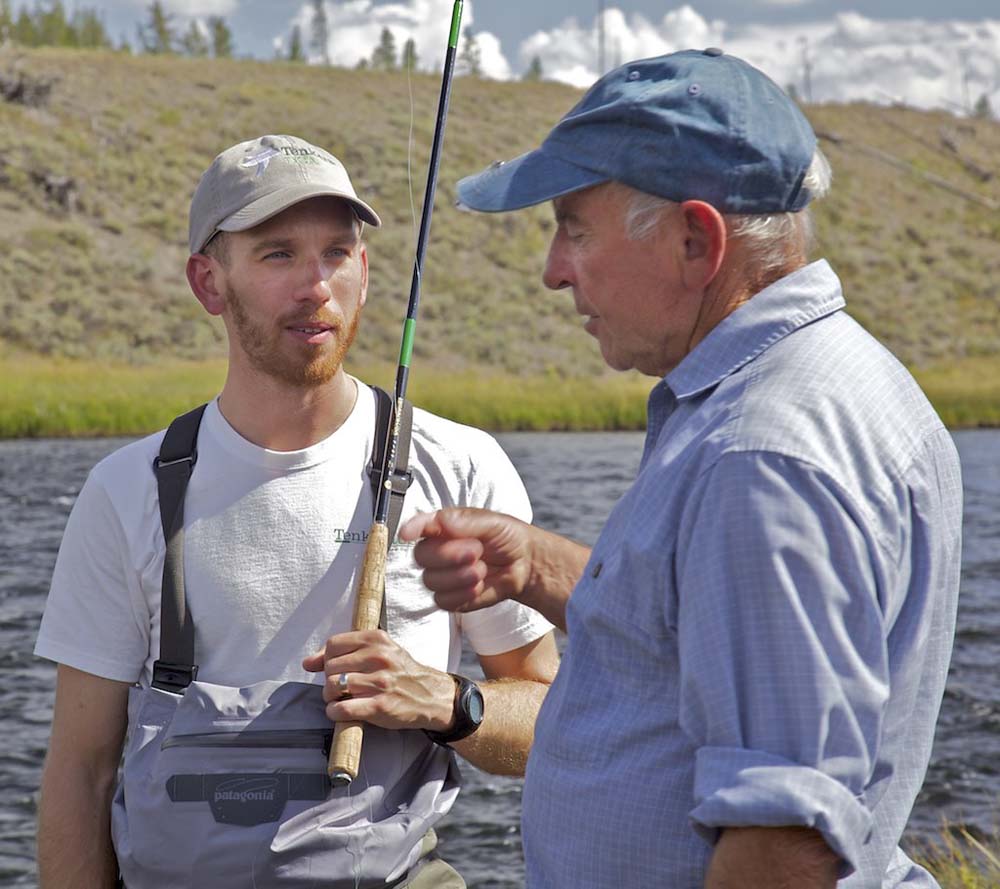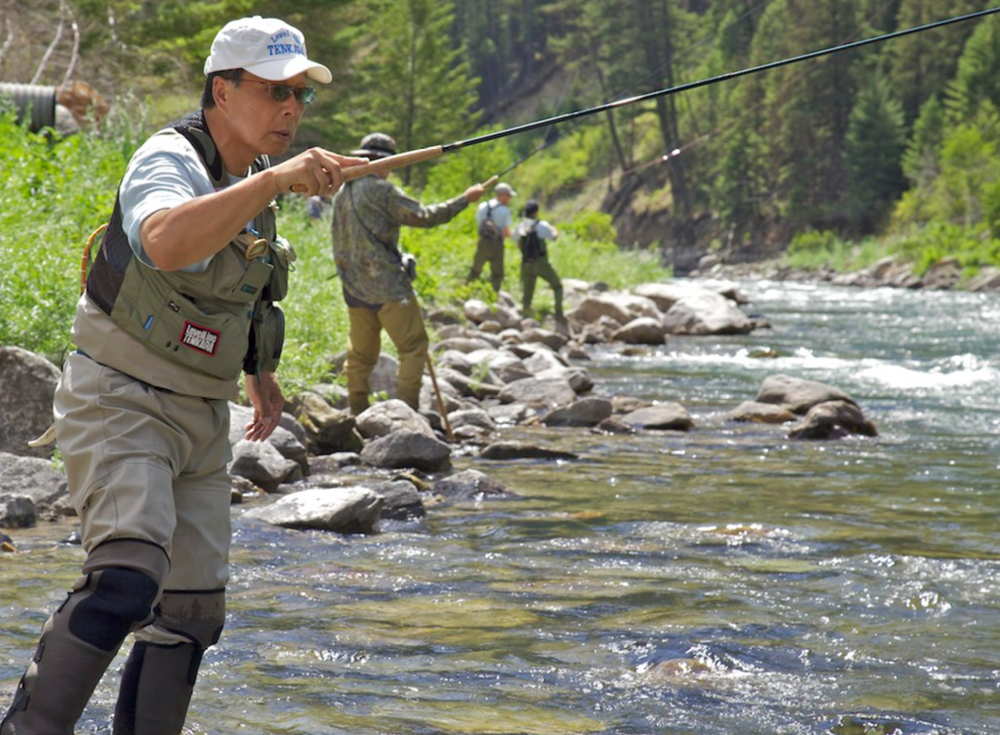
Daniel Galhardo [founder of Tenkara USA] and Yvon Chouinard [founder of Patagonia] talking Tenkara at the 2011 Tenkara USA Summit.
Couch potato fly fishers don’t seem to know much
By Skip Clement
A few years ago, I coordinated a fall trout fishing trip covering North Georgia and Southwest North Carolina with a curiosity stop at a Tenkara [tenkara is not capitalized, but I can’t help myself] happening in the latter state.
The Tenkara event in Cherokee, NC, was a small but enthusiastic gathering of mostly 20s and 30s anglers, and almost 100% men. They had similar fishing backgrounds – jumped into fly fishing for the first time, transferred their fly fishing energies to what they called a more graceful rise, or returned to it because of Tenkara’s simplicity of application compared to the complexities of conventional fly casting, which had baffled them.
Tenkara [‘fishing from heaven,’ or ‘fishing from the skies’] was singlehandedly imported to the US by Daniel Galhardo in 2009 and is now a worldwide fly fishing phenomenon with anglers enjoying it throughout the rest of the civilized world because of his efforts.
Its origin, Japan, is perhaps the source of the first fly fishing in the world. Some, however, point to Dame Juliana Berners and her Treatyse of fysshynge wyth an Angle in 1496, which in some academic circles contest her authorship. Nonetheless, it remains recognized as the earliest anglo mention of fly fishing.

Dr. Ishigaki fishing with Chris Stewart, Daniel Galhardo and Masaki Nakano on the Gallatin river.
At the Tenkara fest, I met a few who are today the face and spokespersons of the Japanese fly fishing system, along, of course, with founder Galhardo of Tenkara USA – the energy behind the whole of Tenkara movement in the free world.
I was intrigued with tenkara, and Daniel kindly ushered me into the fold with an insider’s view of best practices which included an industry discount on two great rods that would cover all my expected freshwater encounters.
My first outings were marginally successful – catching stocked rainbows did not lift my confidence or hoped for romance with Tenkara. It was going to take more than ridding my snobbery and equipping myself to become a decent Tenkara angler. I fessed up that I was no pro at Tenkara to a more seasoned veteran Thom Glace who shared his experiences and maturation as a Tenkara master. I quickly progressed, having been honest about what stumped me.
The enjoyment and practicality of carrying pocketed fly fishing gear while pursuing forested approaches guarding riverine hosts of trouts improved my venue options and my safe arrival and departure, and that of my fly rod/s and equipment.
Other of life’s matters interrupted all my angling and a few years went by
I have reinvested in Tenkara because I can no longer walk the Bahamas flats all day searching for bones and permits, straddle fast currents in the world’s venues, or hike Overlanding trails with long rods in hand. Instead, I need both hands and a light hip pack to negotiate natural forest obstacles – it makes a huge difference to an octogenarian. So, too, anyone suffering from upper limb issues is enabled by the more [much more] relaxed Tenkara casting.
Tenkara’s popularity has quickened the pace of Walmart-type copies of telescoping fly rods. If one wanted to get into Tenkara as inexpensively as possible, the big box store rods are not worthless, but beware of conversations stating these inexpensive rods are as good as name brands. Those statements lack veritas like those of alt-right leanings and Tucker and Laura claiming COVID Vaxxing is a conspiracy and dangerous to one’s health. But, of course, a lie about fly rod performance will not kill you, but believing shameless alt-right politicians, and Tucker and Laura could and has.

Daniel Galhardo, founder of Tenkara USA, talks to author John Gierach about his interest in Tenkara, which is part of Gierach’s new book “All Fishermen are Liars.”
Tying sakasa kebari flies
Kebari is the Japanese word for ‘fly,’ where ‘ke’ means hair, and ‘bari’ is the word for hook, so ‘haired hook.’ Sakasa is the Japanese term for ‘reverse.’ So, a sakasa kebari is one of the characteristic ‘reverse hackle’ flies. The sakasa kebari flies are said to be more seductive than conventional surface dry flies. Thom Glace and a few other Tenkara specialists I’ve bumped into say that fly fishing Tenkara style with sakasa kebari flies are never to be dragged but kept with the advantage of their reverse tie and sitting atop the water like a lotus. Daniel Galhardo is so convinced of the lotus effect of sakasa kebari flies that he reportedly only uses ‘one’ pattern.
Pay close attention to how you Tenkara cast
One could easily mistake someone fly fishing Tenkara with someone ‘dapping,’ which is an Englander term and does not express degradation of fly fishing, but it is offensive to many US Tenkara devotees. That said, it remains important to embrace the subtilties of a cast fly using Tenkara. The best example for me learning the Tenkara cast technique has been letting the trout know that self service is open for business. Yes, that means wanting a trout or trouts to be aware that food has arrived. The trick, which you’ve already figure out, is not land like a rock. Another technique, which is also universal, is to let the trout ‘discover’ the fly. And search casting is also done in a universal fly fishing way: cast right in front of where you’re standing, slowly move casts outward, move English style which is one-step forward after each cast.

